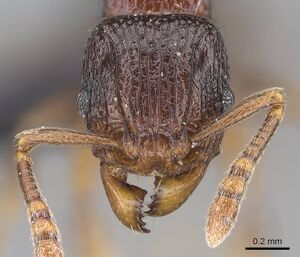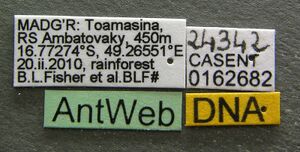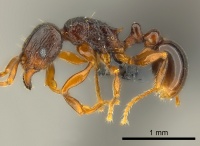Tetramorium tenuinode
| Tetramorium tenuinode | |
|---|---|

| |
| Scientific classification | |
| Kingdom: | Animalia |
| Phylum: | Arthropoda |
| Class: | Insecta |
| Order: | Hymenoptera |
| Family: | Formicidae |
| Subfamily: | Myrmicinae |
| Tribe: | Crematogastrini |
| Genus: | Tetramorium |
| Species group: | schaufussii |
| Species complex: | cognatum |
| Species: | T. tenuinode |
| Binomial name | |
| Tetramorium tenuinode Hita Garcia & Fisher, 2014 | |
Tetramorium tenuinode appears to be a leaf litter inhabitant since almost all of the material was collected from this microhabitat.
Identification
A member of the Tetramorium cognatum species complex of the Tetramorium schaufussii species group. Hita Garcia and Fisher (2014) - The following character set clearly distinguishes T. tenuinode from the remainder of the T. cognatum species complex: eyes relatively large (OI 25–27); antennal scapes very short (SI 66–70); frontal carinae well developed, noticeably raised, and approaching or ending at posterior head margin; petiolar node high rounded nodiform, in profile around 1.8 to 2.2 times higher than long (LPeI 45–54), in dorsal view around 1.3 to 1.4 times wider than long (DPeI 125–143); mesosoma with only two pairs of long, standing hairs, one on anterior pronotum and one on anterior mesonotum.
This new species is easily identifiable within its species complex. The presence of well developed, raised, and long frontal carinae separates T. tenuinode from the species Tetramorium aspis, Tetramorium camelliae, Tetramorium cognatum, Tetramorium karthala, and Tetramorium rumo. These five species are generally also much smaller (WL 0.56–0.81) than T. tenuinode (WL 0.76–0.94). Also, T. tenuinode possesses much larger eyes (OI 25–27) than Tetramorium gladius (OI 19–20) and much shorter antennal scapes (SI 66–70) than Tetramorium myrmidon and Tetramorium proximum (SI 74–77). Lastly, the presence of two pairs of long, standing hairs on the dorsal mesosoma distinguishes T. tenuinode from Tetramorium freya, which lacks any standing hairs on the dorsal mesosoma. The latter species also displays weaker sculpture on the head and mesosoma than T. tenuinode.
It should be noted, however, that T. tenuinode is morphologically still very close to T. proximum, and on very superficial observation it is possible to confuse both. At the initial stage of the revision we considered T. tenuinode conspecific with T. proximum, a very variable species. However, after the detailed examination of more than five hundred pinned workers, it became apparent that the material consisted of these two fairly distinct species. Indeed, even though T. proximum is more broadly distributed than T. tenuinode, both co-occur in sympatry throughout most of their respective distribution ranges, and both are always very well distinguishable. The most obvious character to separate both species is pilosity on the dorsal mesosoma. In T. tenuinode this consists of two pairs of long, standing hairs only, one on anterior pronotum and one on anterior mesonotum, which contrasts with the usually five to six (rarely four or more than six) pairs found from anterior pronotum to posterior mesonotum in T. proximum. In addition to mesosomal pilosity and the shorter antennal scapes mentioned above, T. tenuinode usually also has a thinner petiolar node in profile, which is around 1.8 to 2.2 times higher than long (LPeI 45–54), while the node of T. proximum is around 1.7 to 1.9 times higher than long (LPeI 52–60). The identification key presented above might suggest that T. tenuinode can be easily confused with T. myrmidon, but this is not the case since the two species differ in a number of characters. Among others, T. tenuinode has a broader head (CI 91–93), shorter antennal scapes (SI 66–70), and a higher petiolar node (LPeI 45–54) than T. myrmidon (CI 88–91; SI 74–76; LPeI 58–60).
In contrast to the more variable T. proximum, T. tenuinode has little observed intraspecific variation. Some populations vary very slightly in propodeal spine length, thickness of the petiolar node, or body colouration.
Keys including this Species
Distribution
Tetramorium tenuinode is widely distributed in eastern Madagascar. It is found with few interruptions in an almost straight line from Grand Lavasoa and Andohahela in the southeast to Ambanitaza in the northeast. (Hita Garcia and Fisher 2014)
Latitudinal Distribution Pattern
Latitudinal Range: -14.67933° to -25.08767°.
| North Temperate |
North Subtropical |
Tropical | South Subtropical |
South Temperate |
- Source: AntMaps
Distribution based on Regional Taxon Lists
Malagasy Region: Madagascar (type locality).
Distribution based on AntMaps
Distribution based on AntWeb specimens
Check data from AntWeb
Countries Occupied
| Number of countries occupied by this species based on AntWiki Regional Taxon Lists. In general, fewer countries occupied indicates a narrower range, while more countries indicates a more widespread species. |

|
Estimated Abundance
| Relative abundance based on number of AntMaps records per species (this species within the purple bar). Fewer records (to the left) indicates a less abundant/encountered species while more records (to the right) indicates more abundant/encountered species. |

|
Habitat
Tetramorium tenuinode clearly prefers rainforests and montane rainforests at elevations from 25 to 1200 m, even though it was also collected several times from guava forest and urban gardens.
Biology
Castes
Images from AntWeb
   
| |
| Holotype of Tetramorium tenuinode. Worker. Specimen code casent0040115. Photographer Michele Esposito, uploaded by California Academy of Sciences. | Owned by CAS, San Francisco, CA, USA. |
   
| |
| Worker. Specimen code casent0162682. Photographer Estella Ortega, uploaded by California Academy of Sciences. | Owned by CAS, San Francisco, CA, USA. |
Nomenclature
The following information is derived from Barry Bolton's Online Catalogue of the Ants of the World.
- tenuinode. Tetramorium tenuinode Hita Garcia & Fisher, 2014: 101, figs. 24B, 25C, 26A, 26B, 39, 64 (w.) MADAGASCAR.
Unless otherwise noted the text for the remainder of this section is reported from the publication that includes the original description.
Description
Worker
(N=12). HL 0.62–0.75 (0.71); HW 0.58–0.70 (0.66); SL 0.40–0.47 (0.45); EL 0.16–0.18 (0.17); PH 0.30–0.36 (0.34); PW 0.42–0.54 (0.50); WL 0.76–0.94 (0.88); PSL 0.11–0.18 (0.14); PTL 0.13–0.17 (0.15); PTH 0.26–0.32 (0.30); PTW 0.16–0.21 (0.20); PPL 0.15–0.22 (0.20); PPH 0.25–0.32 (0.30); PPW 0.24–0.33 (0.30); CI 91–93 (92); SI 66–70 (68); OI 25–27 (26); DMI 55–59 (57); LMI 38–40 (39); PSLI 17–24 (20); PeNI 36–42 (39); LPeI 45–54 (49); DPeI 125–143 (133); PpNI 57–64 (61); LPpI 60–72 (67); DPpI 143–168 (153); PPI 148–167 (155).
Head longer than wide (CI 91–93); in full-face view posterior head margin weakly to moderately concave. Anterior clypeal margin with distinct median impression. Frontal carinae well developed, noticeably raised, diverging posteriorly, approaching or ending at posterior head margin. Antennal scrobes weakly developed, shallow and without clear and distinct posterior and ventral margins. Antennal scapes very short, not reaching posterior head margin (SI 66–70). Eyes relatively large (OI 25–27). Mesosomal outline in profile flat to weakly convex, moderately low and long (LMI 38–40), moderately marginate from lateral to dorsal mesosoma; promesonotal suture absent; metanotal groove very weak to absent. Propodeal spines short to moderately long, usually elongate-triangular, and acute (PSLI 17–24), propodeal lobes short and triangular, always much shorter than propodeal spines. Petiolar node in profile high rounded nodiform and relatively thin, around 1.8 to 2.2 times higher than long (LPeI 45–54), anterior and posterior faces approximately parallel, anterodorsal and posterodorsal margins usually situated at about same height and moderately rounded, petiolar dorsum distinctly convex; petiolar node in dorsal view around 1.2 to 1.4 times wider than long (DPeI 125–143), in dorsal view pronotum between 2.4 to 2.8 times wider than petiolar node (PeNI 36–42). Postpetiole in profile subglobular and weakly anteroposteriorly compressed, around 1.4 to 1.7 times higher than long (LPpI 60–72); in dorsal view between 1.4 to 1.7 times wider than long (DPpI 143–168), pronotum around 1.6 to 1.7 times wider than postpetiole (PpNI 57–64). Postpetiole in profile appearing more voluminous than petiolar node, postpetiole in dorsal view around 1.5 to 1.7 times wider than petiolar node (PPI 148–167). Mandibles completely unsculptured, smooth, and shiny; clypeus irregularly longitudinally rugose/rugulose with two to seven rugae/ rugulae, median ruga rarely fully developed, usually broken, most other rugulae usually broken, sometimes merging with each other; cephalic dorsum between frontal carinae longitudinally rugose, usually with six to seven, rarely eight or nine rugae, rugae running from posterior clypeal margin to posterior head margin, often interrupted, splitting up or with cross-meshes, especially posteriorly; scrobal area partly unsculptured, but mostly merging with surrounding longitudinally rugose to reticulate-rugose sculpture present on lateral head. Ground sculpture on head weakly to moderately punctate. Dorsum and sides of mesosoma reticulate-rugose/rugulose to irregularly longitudinally rugose/rugulose, lateral pronotum sometimes only weakly sculptured and relatively smooth and shining. Forecoxae mostly unsculptured, smooth and shining, sometimes with traces of ground sculpture. Ground sculpture on mesosoma usually weak to absent. Both waist segments and gaster fully unsculptured, smooth, and shining. Dorsum of head with several pairs of long, fine, standing hairs; dorsum of mesosoma with two pairs only, one on anterior pronotum and one on anterior mesonotum; propodeum, waist segments and first gastral tergite without any standing hairs at all; first gastral tergite with very short, scarce, appressed pubescence. Anterior edges of antennal scapes and dorsal (outer) surfaces of hind tibiae usually with appressed, rarely decumbent, hairs. Head, mesosoma, waist segments and gaster usually uniformly chestnut brown to very dark brown, sometimes of lighter reddish brown; appendages usually of slightly lighter brown than remainder of body.
Type Material
Holotype, pinned worker, MADAGASCAR, Fianarantsoa, Parc National de Ranomafana, Vatoharanana River, 4.1 km 231° SW Ranomafana, 21.29°S, 47.43333°E, 1100 m, montane rainforest, sifted litter (leaf mold, rotten wood), collection code BLF08400, 27.–31.III.2003 (B.L. Fisher et al.) (California Academy of Sciences: CASENT0040115). Paratypes, 41 pinned workers with same data as holotype (CAS: CASENT0039644; CASENT0039646; CASENT0039651; CASENT0039655; CASENT0039660; CASENT0039664; CASENT0039668; CASENT0039671; CASENT0039673; CASENT0039737; CASENT0039739; CASENT0039745; CASENT0039749; CASENT0039750; CASENT0039754; CASENT0039759; CASENT0039761; CASENT0039809; CASENT0040000; CASENT0040020; CASENT0040023; CASENT0040035; CASENT0040036; CASENT0040090; CASENT0040092; CASENT0040096; CASENT0040099; CASENT0040105; CASENT0040106; CASENT0040112; CASENT0040123; CASENT0040181; CASENT0040279; CASENT0040284; CASENT0040285; CASENT0040293; CASENT0040296; CASENT0040304; CASENT0040306; CASENT0040311; CASENT0040317); and nine pinned workers with same data as holotype except collected ex rotten log and collection code BLF08488 (The Natural History Museum: CASENT0497623; CAS: CASENT0497621; Museum of Comparative Zoology: CASENT0497622).
Etymology
The name of the new species is a combination of the Latin adjective “tenuis”, meaning thin, and the Latin noun “nodus”, meaning node.
References
References based on Global Ant Biodiversity Informatics
- Hita Garcia F, and B. L. Fisher. 2014. The hyper-diverse ant genus Tetramorium Mayr (Hymenoptera, Formicidae) in the Malagasy region - taxonomic revision of the T. naganum, T. plesiarum, T. schaufussii, and T. severini species groups. ZooKeys 413: 1-170.

